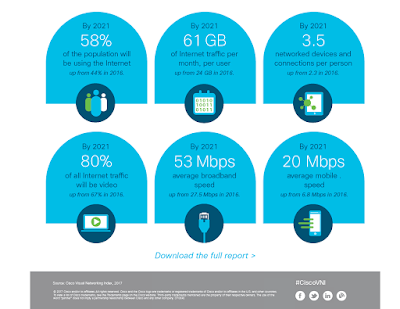Cisco: expansion of the IP universe is accelerating
Cisco has just published its latest Visual Networking Index, an annual report that uses network traffic data from its service provider customers to forecast usage patterns for the next four years. Cisco has been publishing these VNI reports for 12 years and over that time has attracted quite a following. The reports are often cited in the media and used by many other network operators, regulators and Internet companies for planning purposes.
The first question on everyone's mind is 'how fast is the Internet growing?' Cisco's answer for this year, along with its responses for the past few years, are as follows:
· 2017: Global IP traffic is expected to increase three-fold from 2016 – 2021, reaching an annual run rate of 3.3 zettabytes by 2021, up from 1.2 zettabytes in 2016. Busy hour Internet traffic is increasing faster than average Internet traffic, and busy hour Internet traffic will grow 4.6-fold (35% CAGR) from 2016 to 2021, reaching 4.3 Pb/s by 2021, compared to average Internet traffic that will grow 3.2-fold (26% CAGR) over the same period to reach 717 Tb/s by 2021.
· 2016: Global IP traffic to nearly triple at a CAGR of 22% over the next five years (2015-2020) as more than a billion new Internet users come online and new applications take hold.
· 2015: Global IP traffic to triple between 2014 and 2019, when it will reach a record 2 zettabytes. This equates to a CAGR of 23% and marks the first global CAGR increase in consecutive VNI forecasts in nearly a decade.
· 2014: Global IP traffic to grow three-fold from 2013 to 2018, reaching 1.6 zettabytes annually by 2018, representing a 21% CAGR over the forecast period.
· 2013: Global IP traffic to reach 1.4 zettabytes (23% CAGR from 2012 to 17).
· 2012: Global IP traffic forecast to be 1.3 zettabytes by 2016.
In short, this year's Cisco's VNI predicts a 26% CAGR for global IP traffic over the next five years, which means that growth is not just ripping along but actually accelerating. The universe is expanding quickly and accelerating. It is an important observation with implications for everyone in the network ecosystem.
Looking at these big numbers for overall Internet traffic, and knowing that video represents such a significant percentage of that 26% CAGR, one cannot help but wonder why Content Delivery Networks (CDNs) would not have mitigated more of this traffic load. Considering the load an all-day Netflix binge on a 4K monitor, if tens of millions of viewers in the same cities and neighbourhoods are engaged in similar behaviour and watching the same shows, how effective are CDNs? The Cisco VNI numbers indicate that CDN traffic is growing even faster! A 44% CAGR globally and even faster in many regions.
Cable provider IP traffic is a different category
One might also think that the 26% CAGR for public IP traffic would be partially due to the migration or planned migration of cable operators to IP delivery platforms. But that is not the case. Cisco VNI has a separate category for Managed IP video, which is defined as IP traffic generated by traditional commercial TV services. It is not considered Internet traffic because its remains within the footprint of a single service provider. Below are the numbers for that category.
The full 2017 VNI report from Cisco is available here: http://www.cisco.com/c/en/us/solutions/service-provider/visual-networking-index-vni/index.html















